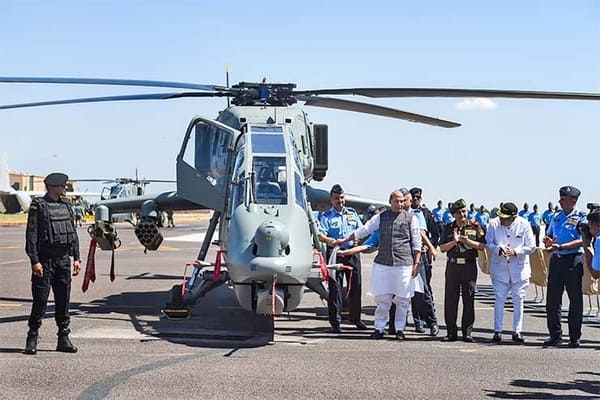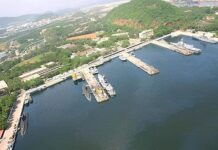Eyes in the Sky Also to be Augmented
Prachand Light Combat Helicopters
The Indian Air Force (IAF) has approached the defence ministry with a proposal to buy 156 ‘Made-in-India’ Prachand Light Combat Helicopters from Hindustan Aeronautics Limited (HAL). It’s a significant move by IAF aimed at bolstering its heliborne strike capabilities. Under the proposed plan, the IAF will induct 66 of the new helicopters, while the remaining 90 will be acquired by the Indian Army.
Having proven its mettle, Prachand, also known as Light Combat Helicopter (LCH) is fully indigenous and designed to meet the specific requirements of the Indian armed forces. Fifteen of these formidable machines have been inducted into the services, demonstrating impressive capabilities in both desert terrains and high-altitude sectors.
The Prachand Light Combat Helicopters were first inducted into the Air Force last year on October 3, and have since been extensively flown in the desert sector. The IAF, impressed with the chopper’s performance, has been conducting integrated exercises with the Army, ensuring readiness for any future conflicts.
The LCH Prachand, functioning primarily as a close air support (CAS) aircraft in high-altitude terrain, excels in roles such as conducting destruction of enemy air defense (DEAD) missions, destroying enemy tanks, executing high-altitude bunker-busting operations, and intercepting slow-moving remotely piloted aircraft (RPAs). Equipped with HAL’s new-generation Shakti engine, co-developed with the French engine-maker Safran, the 5.8-tonne helo has been designed to operate at altitudes of up to 20,000 feet.
As the only helicopter in the world with the capability to operate at altitudes above 5,000 to 6,000 meters while carrying a substantial offensive payload, Prachand choppers are ideal for operations in high-altitude areas like the Siachen glacier and Eastern Ladakh. Equipped with a range of air-to-ground and air-to-air missiles, they can effectively neutralise enemy air defences. Their navigation system allows pilots to identify and destroy targets with ease, enhancing their combat effectiveness.
ALSO READ: IAF MODERNISATION – Airbus C-295 Transport Aircraft Inducted
Prachand holds the distinction of executing successful landings at forward camps situated at Siachen, an altitude of 4,700 meters above sea level, while carrying a 500 kg payload. Prachand comes armed with a 20-millimeter (mm) cannon mounted below its nose, capable of piercing light armour with a fire rate of one thousand bullets per minute. It also carries 70-mm rockets on pods on either side. Additionally, Prachand will be armed with advanced Dhruvastra air-to-ground missiles, designed to target hardened enemy shelters in high-altitude and diverse terrains.
12 Sukhoi-30 MKI Jets to be Acquired
The Defence Acquisition Council (DAC), on 15 September, approved the acquisition of 12 more Sukhoi-30 MKI fighter jets with associated equipment from Hindustan Aeronautics Limited (HAL). HAL produces the Russian-origin twin-engines Sukhoi. In all, 272 Sukhois have been inducted into the Indian Air Force in batches since 1998. The 12 additional planes are to tide over the shortfall caused by crashes and to address the failing number of fighter jet squadrons.
At least from mid-2020 the Indian Air Force (IAF) is seeking authorization to procure a dozen new Su-30MKIs to maintain the strength of its squadrons, and replenish attrition losses suffered since the model entered service.
This new order also benefits the broad supplier base developed by HAL of more than 2,000 micro, small and medium-sized enterprises (MSMEs) for the Sukhoi Su-30MKI license manufacturing project.
HAL’s proposal for a thorough mid-life modernization of these aircraft, which are the Air Force’s main defensive and deterrent element, under the Super Su-30MKI project, is also pending. The core elements of the plan are:
• Replacement of the AL-31FP engines, with the more modern and powerful Saturn AL-41F1S (the same ones that equip the mighty Sukhoi Su-35);
• Replacement of the Russian Bars radar type PESA, by an enlarged version of the Indian designed AESA radar called Uttam, which is being developed for the Tejas Mk2 (and last batches of the Tejas Mk1A);
• New locally developed infrared search and targeting system (IRST);
• New Indian defensive and electronic warfare systems;
• Glass Cockpit incorporating 2 large led touch screens (same configuration as Su-35 and Su-57);
• Incorporation of indigenously developed smart weapons;
• Possible work to reduce its forward radar signature (RCS);
• New indigenous mission computers.
Weapon Systems Branch To Get First Batch
The IAF will get its first batch of weapon systems officers for handling missiles, drones and space-based systems.
The IAF has got the government sanction for establishing this branch to handle weapon systems, freeing the fighter pilots for their core competence, flying combat jets.. The first batch of 33 officer cadets will join the (IAF) academy at the beginning of next year and will get commissioned at the end of next year as weapon system branch officers.
A dedicated weapon system school would be set up at Air Force Station, Begumpet. The new branch will have four sub-branches – to operate the weapons in twin and multi-crew aircraft; for handling space-based intelligence and satellite images; to operate remotely piloted aircraft and mission commanders and operators for surface-to-ground weapons, surface-to-surface missiles and close-in weapon systems.
The training will occur in two stages – the first stage will be conducted at the IAF academy at Dundigal, whereas the second part of the training will be conducted at the new school at Begumpet. The syllabus would be common for all the four sub-branches.
In 2022, while making the announcement, the IAF chief stated that the introduction of such a branch would save the air force of Rs 3,400 crore on training – as trained pilots would not be taken away for non-flying tasks.
Netra-I Surveillance Aircraft
With the aim to enhance its surveillance capabilities along the border regions with China and Pakistan, the IAF is preparing to acquire six additional indigenous Netra-I surveillance aircraft at cost of over Rs 8,000 crore. These aircraft are part of the Netra-I Airborne Early Warning and Control program, which finds its foundation in the Brazilian Embraer aircraft.
The IAF currently operates two Netra-I aircraft, which were created through the efforts of the DRDO.
DRDO and IAF officials have already started looking for sources to acquire the Embraer ERJ-145 aircraft to modify them for carrying the radar on it after modification.
To address its surveillance requirements, the Indian Air Force currently relies on a combination of three Israeli AWACS (Airborne Warning and Control System) and two Netra surveillance planes.
ALSO READ: NAVY MODERNISATION – Navy Receives New P-8I Surveillance Aircraft
As part of the broader initiative, the Netra-2 AEW&C (Airborne Early Warning and Control) project will be undertaken, involving the modification of six A-321 aircraft to transform them into dedicated surveillance aircraft. This strategic move is expected to result in the addition of approximately 13 more AEW&C planes to India’s fleet over the next five to ten years, further augmenting the nation’s aerial surveillance capabilities.
Dornier Do-228 Aircraft
The first of six state-of-the-art upgraded Dornier Do-228 aircraft, manufactured by HAL, was inducted into the IAF in September, to bolster the IAF’s operational capabilities with its advanced features. In March 2023, the defence ministry had inked a deal with HAL for the procurement of six Dornier-228 aircraft, allocating a budget of Rs 667 crore.
The Dornier-228 aircraft has a rich history within the IAF, having been employed for Route Transport Role and communication tasks.
These upgraded Dornier-228 aircraft come equipped with a range of advanced features that set them apart. The inclusion of new engines, composite propellers, advanced avionics, and a modern glass cockpit significantly enhances their performance and usability. Their ability to operate from semi-prepared or short runways makes them particularly valuable, especially in the challenging terrains of the northeastern and island regions of India.


















